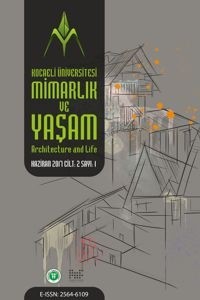Loft Yaşam ve Soylulaştırma: İstanbul Galata Bölgesi Örneği Değişimin Loft Tasarımlar Üzerinden Okunması
1950’li yıllarda New York kentindeki soylulaştırma süreci, ekonomik yeniden yapılanma hareketleri sonucunda loft yaşamı üretmiştir. Loft yaşam, İstanbul’da yakın geçmişte ortaya çıkmış ve loft tasarımlar tekil örnekler ile görülmektedir. Bu çalışmanın amacı İstanbul’da mikro ölçekte meydana gelen soylulaştırma süreci sonucunda Galata’da ortaya çıkan loft yaşam ve loft tasarımları incelemektir. Çalışmada loftlar, mekansal ölçüt ve tipleri ile tanımlanmış; Galata’da soylulaştırma sürecinin mimari bir sonucu olarak loft tasarımlar incelenmiş ve bu süreçteki sosyo-kültürel değişimin bu tasarımlar üzerinden okuması gerçekleştirilmiştir. Seçilen örnekler, gözlem, röportaj ve fotoğraflar aracılığı ile incelenmiştir. Analiz tablosunda loftlar, isimleri, yapım tarihleri, dönüştürme tarihleri, kullanıcı profilleri ile incelenmiş ve belirlenen kriterlere göre bu loftların yapısal ve işlevsel açıdan hangi loft tipine karşılık geldiği analiz edilmiştir. Sonuçta, Galata’daki ilk soylulaştırma hareketleri ile ortaya çıkan ve ‘karma kullanımlı orijinal loft’ özelliği gösteren loftların, tekil örnekler ile halen varlığını sürdürdüğü; bölgeye artan ilgi nedeniyle özellikle ‘ticari kullanımlı loft’ özelliği gösteren loftların sayısının arttığı ve son olarak büyük inşaat firmalarının tüm binayı satın alarak dönüştürdükleri ‘konut kullanımlı ara loft’ veya loft yaşamı bir ticari imaj olarak kullanarak inşa ettikleri ‘konut kullanımlı sahte loft’ özelliği gösteren yeni loftların ortaya çıktığı gözlemlenmiştir.
Anahtar Kelimeler:
loft iç mekan tasarımı, loft yaşam, loft dönüşümü, sosyo-mekansal değişim, soylulaştırma
Loft Living and Gentrification: A Case for Istanbul Galata District Reading Change through Loft Designs
Following economic restructuring movements in 1950s, loft living first emerged as a result of gentrification process in New York City. In Istanbul, loft living became available recently and loft designs have represented in limited cases. This paper aims to examine loft living and loft designs in Galata, emerged as a result of micro-scale gentrification process in Istanbul. The research defines lofts in terms of spatial criteria; examines loft designs as an architectural result of gentrification process in Galata and aims to read the socio-cultural change through these designs. Selected lofts were examined through observations, interviews and photographs. The analysis table specifies names, construction dates, conversion dates, user profiles and according to criteria predetermined as part of the research, investigates what type these lofts correspond in structural and functional terms. Consequently, lofts emerged following the initial gentrification movements in Galata (original lofts converted for mixed-use) still exist in district; the number of ‘lofts converted for commercial use’ has increased due to the recent popularization of the area. Besides, ‘semi-lofts converted for residential use’ and ‘imitation lofts built for residential use' reflecting just the commercial image of loft living and realized by large-scale construction firms, have emerged.
___
- Ciravoğlu, A., Islam, T. (2006). Çağlar Keyder: soylulaştırma, kapitalizmin kentsel mekan düzeyinde yansımasıdır (Çağlar Keyder: gentrification is a reflection of capitalism on urban space). Mimar.ist, 21, 46-51.
- Dalgiçer, M. (2011). Beyoğlu’nun Soylulaştırılmasında Münferit Hareketler: Galata Bölgesi. (Individual Movements in the Gentrification of Beyoğlu: Galata District) Master’s thesis, Istanbul Technical University, Istanbul.
- Ergun, N. (2004). Gentrification in Istanbul. Cities, 21(5), 391-405.
- Glass, R. (1964). Aspects of Change, in Centre for Urban Studies London. London: Macgibbon and Kee.
- Gomez, L. (2003). Lofts, living, working and trading in Loft. China: H.F. Ullmann.
- Güvenç, M. (2006). Gentrification kavramı nasıl Türkçeleştirilmeli (How should we translate gentrification?). Mimar.ist, 21, 39-45.
- Hamnett, C. (1984). Gentrification and Residential Location Theory: a Review and Assessment in D. Herbert, R.J. Johnston (Eds.). Geography and the Urban Environment: Progress in Research and Applications. 282-319. New York: Wiley and Sons.
- Harris, C. M. (1993). Dictionary of Architecture & Construction, 2nd edition. USA: Mc Graw-Hill Inc.
- Islam, T. & Ciravoğlu, A. (2006). Soylulaştırma ve Istanbul (Gentrification and Istanbul). Mimar.ist, 21, 37-38.
- Islam, T. (2002). Gentrifıcation in Istanbul: A Comparison of Different Cases, in Upward Neighborhood Trajectories: Gentrification in a New Century Conference, Glasgow, Scotland.
- Islam, T. (2005). Outside the Core: Gentrification in Istanbul in R. Atkinson, G. Bridge (Eds.). Gentrification in a Global Context, the New Urban Colonialism. New York: Routledge.
- Karagöz, Z. (2007). Tasarımda Loft Anlayışı (Loft Concept in design). Master’s thesis, Istanbul Kultur University. Istanbul.
- Kuban, D. (2006). Soylulaştırma (Gentrification). Mimar.ist, 21, 57-60.
- Özker, S. (2014). A Review of Lofts as Housing in Istanbul. Open House International, 39(1), 56-68.
- Pamukçu, K. Ö. (2009). Ticari ve Endüstriyel Yer Değiştirmenin Sonucu Olarak; Loft Mekanlarının Değerlendirilmesi. (Evaluation of ‘Lofts’ as a Consequence of Commercial and Industrial Translocation) Master’s thesis. Yildiz Technical University, Istanbul.
- Şişmanyazici, B., Turgut, H. (2010). Tarihi kentsel alanlarda toplumsal ve mekansal yeniden yapılanma: Fener ve Balat örneği (Social and spatial restructuring in historic urban areas: example of Fener and Balat), Mimarlık, 352, 28-35.
- Taner, S. (2011). Istanbul Endüstri Yapılarının Loft Kavramı Çerçevesinde Yeniden Işlevlendirilmesi. (Adaptive Reuse of Industrial Buildings in Istanbul in Context of Loft Concept) Master’s thesis, Istanbul Technical University, Istanbul.
- Van Criekingen, M. & Decroly, J. M. (2003). Revisiting the diversity of gentrification: neighbourhood renewal processes in Brussels and Montreal. Urban Studies, 40(12), 2451-2468.
- Zukin, S. (1989). Loft living, Culture and Capital in Urban Change. New Jersey: Rutgers University Press.
- Internet References
- URL-1. https://www.archdaily.com/291739/ipera-25-alatas-architecture consulting/ 509c4affb3fc4b2c5500004f-ipera-25-alatas-architecture-consulting-photo?next_project=no, last accessed on 03.02.2021
- ISSN: 2564-6109
- Başlangıç: 2016
- Yayıncı: Kocaeli Üniversitesi
Sayıdaki Diğer Makaleler
Sergileme Mekânlarında Yapay Aydınlatma Uygulamaları
Merve KARAOĞLU CAN, Damla ALTUNCU
Yoncaaltı Cami ve Medresesi’nin Mimari Özelliklerinin İncelenmesi
Akıllı Kampüs Teknolojileri ve Uygulamaları Üzerine Bir Araştırma
Gamze ALTUN, Murat ZENCİRKIRAN
Evden Çalışmada Sirkadiyen Aydınlatmanın Çalışma Verimliliğine Etkisi
Cahide AYDIN İPEKÇİ, Ayşe Feyza KARAKOÇ
Görünmeyen Sınırların Kentsel Dönüşüm Projeleri ile Değişimi: İzmir Kadifekale Örneği
Güncel Mimaride Yerel Malzemenin İzi
Edanur FETTAHOĞLU, Şengül YALÇINKAYA
Konut Tasarımında Etkili Olan Faktörler ve Geleneksel Mimari Yaklaşımlar: Şile’de Bir Konut Örneği
